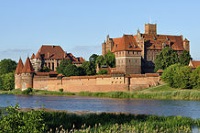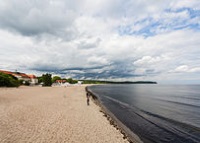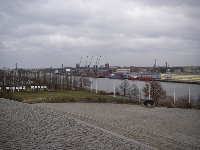
Malbork Castle is the world's largest brick fortress and one of the most impressive in Europe. The Teutonic Knights built it in 1276 and slowly began to establish themselves as fearsome rulers, taking control of most of Poland until they were defeated at the Battle of Grunwald in 1410. The immense brick stronghold incorporates a system of multiple defence walls with gates and towers, guarding an interior of arcaded courtyards, chapels, a treasury, the Knights' Hall, and an armoury. The castle houses several exhibitions of tapestries, coins and medals, medieval sculptures, and weapons. During summer, the courtyard is used as a venue for sound and light shows. Guided tours are available and there are audio guides for those who prefer to explore independently, although the number of audio guides is limited.
Address : Staroscinska 1, 82-200 Malbork, Poland
Website : www.zamek.malbork.pl
Telephone : +48 55 647 08 00
Transport : 31 miles (50km) from Gdansk by train or bus
Opening times : 9am to 7pm, Monday to Sunday.

Although still very much a well-kept secret on the mainstream tourist scene, Northern European travellers have been flocking to Sopot for many years for its gorgeous sandy beaches on the shore of the Baltic Sea. Primarily a beach resort and health spa town, Sopot buzzes every summer. Throngs of visitors walk along its famous wooden pier while enjoying the long sunny days and numerous restaurants, bars, and shops. There are a few other tourist attractions in the town, like a museum and a water park, but the beachfront is the highlight. With its vibrant nightlife and relative obscurity, Sopot is the perfect cheaper option for budget travellers and backpackers.

The peninsula of Westerplatte saw the beginning of Second World War. A small Polish garrison heroically held out against the attack of seven days before surrendering to German forces, with the site now a towering memorial to the defenders. With only 180 Polish soldiers, they fought on knowing they had no chance of reinforcement or resupply. A small museum is accompanied by ruins of the barracks and guardhouses left from the shelling, standing harrowing and dilapidated in an otherwise picturesque setting reachable by bus. Surrounding scenery is best appreciated on a boat or bike trip.

Travel Guide powered by Word Travels, copyright © 2023 Globe Media Ltd. By its very nature information in this travel guide is subject to change at short notice and travellers are urged to verify information on which they're relying with the relevant authorities. Neither Globe Media Ltd nor Travel Vogue can accept any responsibility for any loss or inconvenience to any person as a result of information contained above.